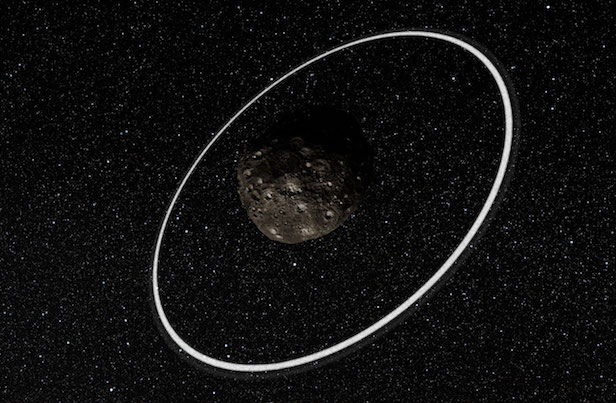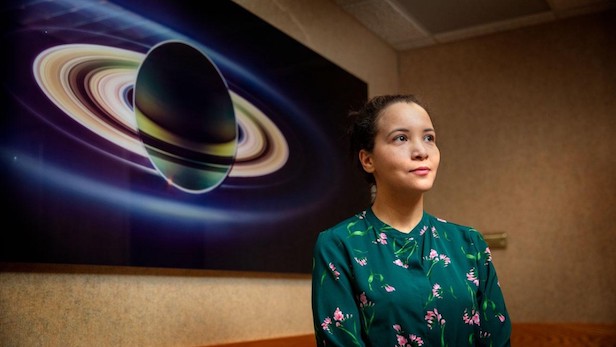Small bodies in the Solar System spotted with their own rings
Asteroid Chariklo and dwarf planet Haumea have managed to form and maintain their own rings

Chariklo is the smallest object by far found to have rings and only the fifth body in the Solar System — after the much larger planets Jupiter, Saturn, Uranus and Neptune — to have this feature. Image credit: ESO/L. Calçada/M. Kornmesser/Nick Risinger (skysurvey.org)
Forget those shepherding moons. Gravity and the odd shapes of asteroid Chariklo and dwarf planet Haumea – small objects deep in our solar system – can be credited for forming and maintaining their own rings, according new research in Nature Astronomy.
“Rings appear around Saturn, Jupiter, Neptune and Uranus, but scientists found rings around Chariklo and Haumea within the last few years. Chariklo and Haumea were the first small objects known to have rings, and we think that rings throughout the solar system are more common than we thought,” says Maryame El Moutamid, a research associate in the Cornell Center for Astrophysics and Planetary Science, New York, United States. “In the case of small bodies Chariklo and Haumea, gravity shepherds the rings. The rings are confined by the gravity because of the shape irregularity of their bodies.”
Until now, scientific literature generally assumed that the gravitational torques from shepherd moons around planets kept the rings in shape and prevented them from spreading and disappearing. Instead, this research shows that a topographic anomaly on the object, such as a mountain, may play a similar gravitational role as a “moon” to hold the rings together.
In addition to gravity, rapidly spinning cosmic bodies that create specific resonance also keep rings from expanding, dissipating and disappearing.

Maryame El Moutamid, part of an international scientific team, has found that gravity – rather than shepherding moons – retains rings around small cosmic bodies. Image credit: Jason Koski/Cornell Brand Communications
Chariklo is a small, rocky asteroid between Saturn and Uranus. It is about 303 kilometres (188 miles) in diameter and takes 63 years to orbit the Sun. It is the largest object in an asteroid class known as Centaurs, according to NASA.
Meanwhile, Haumea, a trans-Neptunian object, about the size of Pluto, looks like a flattened ball with a 620 kilometre (385-mile) diameter. It is found in the Kuiper Belt, a region beyond the orbit of Neptune. Haumea was discovered in December 2004 and takes about 285 years to orbit the Sun.
With Saturn, the rings are shepherded by tiny moons to keep them in place. But for Chariklo, its odd, rocky shape – which includes a large “mountain” – keeps the rings in place just beyond the border of the Roche limit – the closest a small object can approach the larger one it orbits without being torn apart by tidal force.
“In the case of Chariklo, the irregularities confine the rings. In the case of Haumea, the body’s big flatness does the job,” says El Moutamid, who is also a member of Cornell’s Carl Sagan Institute.
Keep up to date with the latest news in All About Space – available every month for just £4.99. Alternatively you can subscribe here for a fraction of the price!




